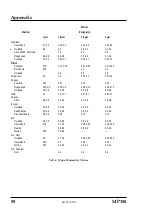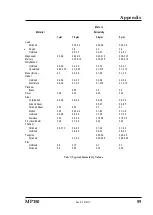
Appendix
60
MP150
N
ON
-M
ETALS
Material
Emissivity
1 µm
1.6 µm
5 µm
Asbestos
0.9
0.8
0.9
Asphalt
0.95
Basalt
0.7
Carbon
0.9
Unoxidized
0.8-0.9
Graphite
0.7-0.9
Carborundum
0.9
Ceramic
0.4
0.8-0.95
Clay
0.85-0.95
Concrete
0.65
0.2
0.9
Cloth
0.4-0.9
0.95
Glass
Plate
0.98
“Gob”
0.9
Gravel
0.95
0.95
Gypsum
0.8-0.95
0.4-0.97
Ice
—
Limestone
0.4-0.98
Paint (non-al.)
0.8-0.9
—
Paper (any color)
0.8-0.9
0.95
Plastic (opaque, over 20 mils)
0.95
Rubber
0.9
Sand
0.9
Snow
—
Soil
—
Water
0.8-0.95
—
Wood, Natural
0.9-0.95
Tab. 8: Typical Emissivity Values
To optimize surface temperature measurements, consider the following guidelines:
•
Determine the object emissivity using the instrument which is also to be used for the
measurements.
•
Avoid reflections by shielding the object from surrounding temperature sources.
•
For higher temperature objects use instruments with the shortest wavelength possible.
•
For translucent materials such as plastic foils or glass, assure that the background is uniform
and lower in temperature than the object.
•
Mount the sensor perpendicular to surface whenever emissivity is less than 0.9. In all cases, do
not exceed angles more than 30 degrees from incidence.

































